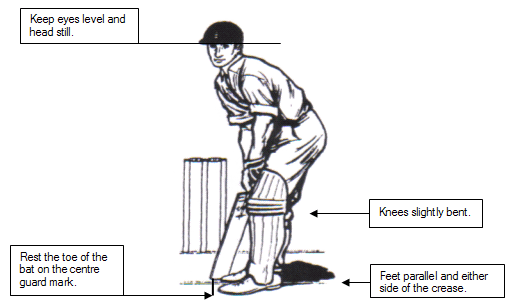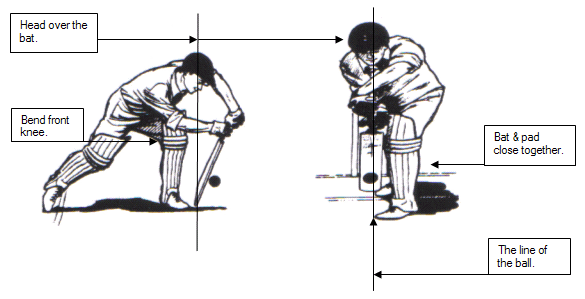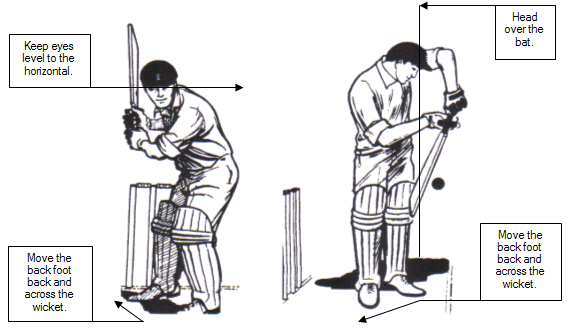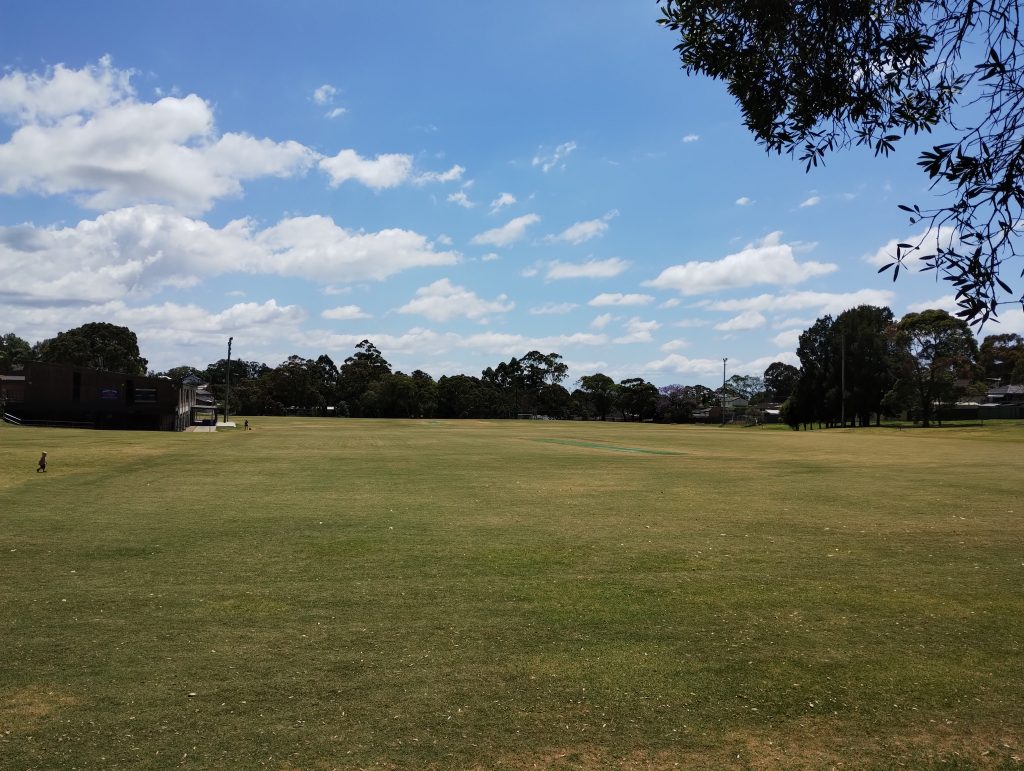PART NO.1 – Grip & Stance

- Take CENTRE guard from umpire and mark it clearly on the pitch with chalk.
- Correct GRIP on bat with the V between thumb and first finger on the top hand should point to the front shoulder, and the V on the bottom hand should point to the back shoulder. Both hands together in the middle of the handle.
- The FEET should be shoulder width apart either side of, and parallel to the batting crease. With the knees slightly bent and the head and eyes level and still. The player should be relaxed and comfortable.
- Place BAT behind the back foot (allows for straight back lift), with the handle resting on the thigh and place the toe of the bat on the centre guard mark.
PART NO.2 – Preparing to face the bowler
- FINE FOCUS on the ball, this will give you a greater period of time to determine and be in position to play your shot.
- Focus on the ball in the hand of the bowler as he runs in to bowl. As the ball leaves the bowlers hand start your BACK LIFT. The back lift should be towards 1st slip and about stump high.
PART NO.3 – Determining which shot to play
- When batting you will have FIVE DECISIONSto make: –
- Forward defence
- Forward attack – Drive
- Backward defence
- Backward attack – Hook, pull & cut
- Leave the ball
- The LINE & LENGTH of the ball will determine the shot you will need to play. Full deliveries play forward, short deliveries play back.
PART NO.4 – Front foot or forward defence

- Watch the ball onto the bat.
- Keep the head steady and over the bat.
- Front elbow bent and high, pointing back towards the bowler. Arms and bat form a figure 9
- Front foot near to the line of the ball, knee slightly bent and weight transferring to the front foot as the body moves forward.
- The bat is moved towards the ball, close to the front pad, with the blade slightly behind the handle.
PART NO.5 – Back foot or backward defence

- The back foot moves back and across the wicket, the weight resting on the back foot as the shot is played.
- The bat is kept close to the pad on the back foot, leaving no gap for the ball.
- The eyes are kept level to the horizontal.
- The front elbow is kept bent and high. The top is controlling the grip, while the bottom hand, thumb and index finger some support and control. Releasing the grip of the bottom hand enables you to make the ball drop at your feet.
PART NO.6 BATTING
Once you are padded up waiting for your turn to bat, get a teammate to throw some full balls to you for a warm up. Then sit down to rest and relax your mind by taking notice of what the bowlers are doing.
Once it is your turn to bat, take centre, middle stump to right-hand bowlers of pace and off-spin.
For left-hand bowlers and right-hand leg-spin, take centre on leg stump; also open your stance to give you a 2-eyed stance. Any balls pitched outside leg stump coming in to you can be played with your front foot and no LBW’s should be given.
Once you have marked centre, place your bat on the mark, not your feet. Have a good look around to see what type of field has been set. Take your time, settle your nerves and get into your mind…”NO ONE IS GOING TO GET ME OUT….I’M BETTER THAN THEM.”
As the bowler is running in watch the ball in the hand of his bowling arm and watch for his wrist movements, especially spin bowlers which should help you know which way the ball will break. Of course wrong-uns are difficult to pick up. Also, if the bowler’s delivery stride is wide of the crease, he is trying to slant the ball into the stumps.
When you are at the bowlers end you can learn what the bowler is doing. In the event of a bowler swinging the ball a great deal, take your stance out of the crease to lessen the amount of swing. Make sure you return to your crease immediately when missing the delivery.
Early in your innings you should try to play straight in the Vee area with your shots. Don’t hit across the line, like cut and hook shots. Once you know what type of delivery the bowler is bowling, play your shots. If the bowling is tight and runs are hard to come by, look for scoring singles and turn the strike over. Make sure when a run is likely and you are at the bowlers end of the pitch you walk slowly in with the bat just inside the crease while looking at the bowlers arm. When the ball leaves the bowlers hand you walk a couple of strides (called BACKING UP) to see if a run is likely. Your call for a run is only for shots behind the batsman on strike. It is his call for shots in front of him. The only time the calls can alter is when a possible run is dangerous. Your call must be loud and clear YES- NO- WAIT.
Run the first run hard, carrying the bat in two hands. Always slide the bat in a close run. When turning for an extra run, don’t turn blind as you touch down with the bat, ensure you are facing the fieldsman fielding the ball.
Pick out the better fieldsmen and any weak ones. Don’t take on the fieldsman with a good arm.
Talk to your batting partner and encourage each other. Try to build up partnerships. If you think he has played a careless shot and got away with it, tell him to concentrate harder. Batting is all about playing the ball on its merits, respecting the good ones and punishing the poor ones with a confident approach, ignoring any smart sledging from the opposition. Don’t let them get you upset, keep your mind on what you have to do when facing the next delivery.
For proper batting practice in the nets you should play yourself in just like you should in a match. Once you have your feet working properly, play your forcing shots. Your mind should be telling you that you must get your feet moving. Front foot to all ball pitched up. Your bat should be close to your front leg. When driving, make sure you only hit the ball on the full or the half-volley (hitting the ball just after it has hit the pitch). If you are not to the pitch of the ball, don’t attempt to drive (hitting on the up). Instead, block the ball with a straight bat, top hand takes over, don’t push the bottom hand through. When playing defensive shots, get your body behind the ball with your head over the ball, eyes watching the ball hitting the bat.
CUTTING LATE OR SQUARE: For short pitched balls outside off-stump you must get your back foot across, hitting the ball with a downward motion preferably the same moment your back foot touches the ground. Your bottom hand takes over when cutting or hooking. When the ball rises sharply, don’t play a shot.
HOOKING: For short pitched balls down the leg side, ensure your head is inside the line of the ball. If not, don’t play a shot, try to dodge the ball. Grip your bottom hand tightly when hooking or pulling.
LEG GLANCE: Most boys find the leg glance difficult. Too many players play the shot with their front leg away from the line of the ball. You must have your front leg placed in line with the ball with your head still, eyes watching the ball onto your bat, turning your wrists to the leg side. If you miss the ball you could gain some leg byes if the ball hits the pads.
YOUR INNINGS: To establish a good innings you must learn when to attack or be defensive. Common sense should tell you that the player who hits the ball along the ground lessens the chance of being dismissed, compared to the player who slogs away happy to hit a boundary or two.
















Comments are closed, but trackbacks and pingbacks are open.